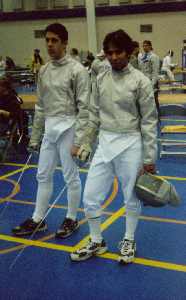|
|
 The saber is based on the cavalry sword of the Civil War. Like the cavalry sword, sabers are slashing weapons. Touches may be scored with either the edge or the tip, unlike either foil or epee. Like foil, saber also has right of way rules to determine who gets the point if touches occur almost simultaniously. Any part of the body from the waste up is considered a valid target. The legs are not targets as the saber was originally used on horseback. The saber is based on the cavalry sword of the Civil War. Like the cavalry sword, sabers are slashing weapons. Touches may be scored with either the edge or the tip, unlike either foil or epee. Like foil, saber also has right of way rules to determine who gets the point if touches occur almost simultaniously. Any part of the body from the waste up is considered a valid target. The legs are not targets as the saber was originally used on horseback.
 Saber is faster paced than any of the other fencing styles. The right of way rules generally award the point to whoever attacks first, as the slashing motion of the saber is harder to parry than a thrusting epee or foil. Often, both competitors will charge at each other and attack as soon as the director calls out, "Fence!" If both hit, and the director determines that they did indeed begin their attacks at the same time, neither fencer gets a point from that action. Saber is faster paced than any of the other fencing styles. The right of way rules generally award the point to whoever attacks first, as the slashing motion of the saber is harder to parry than a thrusting epee or foil. Often, both competitors will charge at each other and attack as soon as the director calls out, "Fence!" If both hit, and the director determines that they did indeed begin their attacks at the same time, neither fencer gets a point from that action.
 Electric saber scoring equipment was only introduced recently. In addition to the standard fencing jacket, knickers, and underarm protectors, saberists wear a lamé over their protective jacket. The lamé resembles a jacket and contains a fine metal mesh fabric which enables the scoring machine to detect hits. An overglove made from the same material covers the hand to register touches scored there. Saberists also use a different kind of mask in electric bouts becuase normal masks are not conductive, and the saber mask is connected to the lamé using a head cord. The body cord is identical to the one used by foilists, with a three prong plug connected to the reel, a two prong plug connected to the saber, and a clip attached to the lame. Electric saber scoring equipment was only introduced recently. In addition to the standard fencing jacket, knickers, and underarm protectors, saberists wear a lamé over their protective jacket. The lamé resembles a jacket and contains a fine metal mesh fabric which enables the scoring machine to detect hits. An overglove made from the same material covers the hand to register touches scored there. Saberists also use a different kind of mask in electric bouts becuase normal masks are not conductive, and the saber mask is connected to the lamé using a head cord. The body cord is identical to the one used by foilists, with a three prong plug connected to the reel, a two prong plug connected to the saber, and a clip attached to the lame.
|


